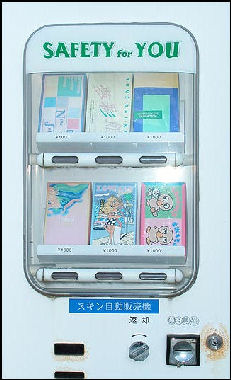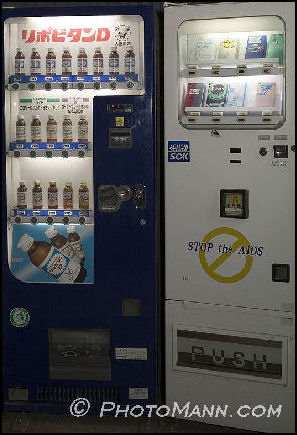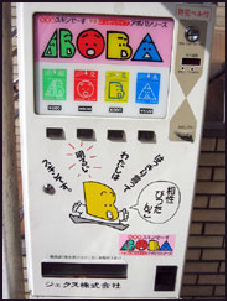Birth Control in Japan

condom vending machine
 Among Japanese that use birth control, 80 percent use condoms, followed by the rhythm method and spermicide jelly. Some use female contraceptives (a cookie-size, thin piece of plastic with a spermicide). Sterilization is practiced among couples that already have kids. Many Japanese don't use contraceptives as illustrated by the high number of shotgun weddings.
Among Japanese that use birth control, 80 percent use condoms, followed by the rhythm method and spermicide jelly. Some use female contraceptives (a cookie-size, thin piece of plastic with a spermicide). Sterilization is practiced among couples that already have kids. Many Japanese don't use contraceptives as illustrated by the high number of shotgun weddings. Japanese birth control policy has often been determined by politics. Abortions were banned in 1907 and all kinds of birth control were made illegal in World War II. In the 1950s, when the population was growing rapidly and women were added in the labor force, abortion were legalized for "economic and health" reasons.
Japanese birth control policy has often been determined by politics. Abortions were banned in 1907 and all kinds of birth control were made illegal in World War II. In the 1950s, when the population was growing rapidly and women were added in the labor force, abortion were legalized for "economic and health" reasons.  Single women are reluctant to visit gynecologists because of the widespread assumption that only reason a single woman would do so would be to obtain an abortion or receive treatment for a sexually transmitted disease. Single women become painfully aware of these assumptions if they are in awaiting room surrounded by pregnant or married women.
Single women are reluctant to visit gynecologists because of the widespread assumption that only reason a single woman would do so would be to obtain an abortion or receive treatment for a sexually transmitted disease. Single women become painfully aware of these assumptions if they are in awaiting room surrounded by pregnant or married women.Birth Control Pills in Japan

condom vending machine next to energy drink machine
 Birth control pills were finally approved in Japan in May 1999, nearly 50 years after they were approved the United States. Before then only high-dose varieties of the pill were available and they were prescribed for menstrual disorders not birth control. These pills carry a higher risk of high blood pressure and some forms of cancer than the low dose versions.
Birth control pills were finally approved in Japan in May 1999, nearly 50 years after they were approved the United States. Before then only high-dose varieties of the pill were available and they were prescribed for menstrual disorders not birth control. These pills carry a higher risk of high blood pressure and some forms of cancer than the low dose versions.  Over the years the Japanese government has supported the ban on the pill on the grounds of sexual morality, AIDS prevention and women's health. Critics have claimed the pill encourages promiscuity, produces side effects such as morning sickness, bloating and strokes and pollutes rivers with hormones. Among the groups opposed to the legalization of birth-control pills were condom makers and health clinics that performed abortions.
Over the years the Japanese government has supported the ban on the pill on the grounds of sexual morality, AIDS prevention and women's health. Critics have claimed the pill encourages promiscuity, produces side effects such as morning sickness, bloating and strokes and pollutes rivers with hormones. Among the groups opposed to the legalization of birth-control pills were condom makers and health clinics that performed abortions.  One of the main reasons approval of birth control pills was finally granted was the outcry over the fact that Viagra was approved with a minimum of fuss by the Japanese-equivalent of the FDA in 1998 after a review process that took only six months while birth control pill had been under review for nine years and remained unavailable 34 years after regulatory approval was first requested. Many women felt there was clearly a double standard. It was said that Viagra was approved so quickly because members of Parliament—mostly old men—wanted to get their hands on the drug.
One of the main reasons approval of birth control pills was finally granted was the outcry over the fact that Viagra was approved with a minimum of fuss by the Japanese-equivalent of the FDA in 1998 after a review process that took only six months while birth control pill had been under review for nine years and remained unavailable 34 years after regulatory approval was first requested. Many women felt there was clearly a double standard. It was said that Viagra was approved so quickly because members of Parliament—mostly old men—wanted to get their hands on the drug.Aversion to Birth Control Pills in Japan

bloody-type condom vending machine
 It was thought that after the pill was legalized, Japanese women would jump at the change to take it. That has not happened. As of 2004, five years after they were legalized, Japanese women continue to shun birth control pills. According to one survey only 1.3 percent of the Japanese females between 15 and 49 used the pill, compared to 15.6 percent in the United States. More than 70 percent the women surveyed said they would never use the pill. Only 20 percent said they world try it.
It was thought that after the pill was legalized, Japanese women would jump at the change to take it. That has not happened. As of 2004, five years after they were legalized, Japanese women continue to shun birth control pills. According to one survey only 1.3 percent of the Japanese females between 15 and 49 used the pill, compared to 15.6 percent in the United States. More than 70 percent the women surveyed said they would never use the pill. Only 20 percent said they world try it.  Reasons why Japanese women avoid the pill, experts say, include ignorance, easy-to-obtain abortions, marketing restrictions, discriminatory pricing and taboos associated with visiting a gynecologist. A month’s supply of birth control pills cost around $30 but women who want the pill sometimes have or pay a $1,000 a year for the pills and extensive tests required to get a prescription.
Reasons why Japanese women avoid the pill, experts say, include ignorance, easy-to-obtain abortions, marketing restrictions, discriminatory pricing and taboos associated with visiting a gynecologist. A month’s supply of birth control pills cost around $30 but women who want the pill sometimes have or pay a $1,000 a year for the pills and extensive tests required to get a prescription.  Many women fear they will gain weight, become infertile, or suffer some other side effect. One woman told the Los Angeles Times, "I hear women can't get pregnant again, even after they stop using it." Another said, "It's much cheaper and easier just to ask men to but condoms. Taking something everyday seems like a real bother."
Many women fear they will gain weight, become infertile, or suffer some other side effect. One woman told the Los Angeles Times, "I hear women can't get pregnant again, even after they stop using it." Another said, "It's much cheaper and easier just to ask men to but condoms. Taking something everyday seems like a real bother."  On the social stigmas attached to birth control pills, one Japanese psychiatrist told Newsweek, "Many women still say, my boyfriend would think I play around if I talked about birth control." One Japanese gynecologist said, "It's easier for a Japanese woman to say she's had an abortion that to say she's on the pill."
On the social stigmas attached to birth control pills, one Japanese psychiatrist told Newsweek, "Many women still say, my boyfriend would think I play around if I talked about birth control." One Japanese gynecologist said, "It's easier for a Japanese woman to say she's had an abortion that to say she's on the pill." Condoms in Japan

Condomania shop
 Condoms are the most common form of birth control. According to a United Nation study, they are used regularly by 46 percent of couples between the ages of 15 and 49 and by 80 percent of the sexually active public who use birth control.
Condoms are the most common form of birth control. According to a United Nation study, they are used regularly by 46 percent of couples between the ages of 15 and 49 and by 80 percent of the sexually active public who use birth control. .
 One reasons they are so popular is that they are easy to obtain with a minimum of fuss and embarrassment. Condoms are sold at all kinds of stores and can be purchased discreetly from vending machines. Condomania in Tokyo sells Skinless Wrinkle Zero-0 condoms and glodoms" that "light up your love life." Sometimes female salespersons sell them door-to-door in respectable neighborhoods.
One reasons they are so popular is that they are easy to obtain with a minimum of fuss and embarrassment. Condoms are sold at all kinds of stores and can be purchased discreetly from vending machines. Condomania in Tokyo sells Skinless Wrinkle Zero-0 condoms and glodoms" that "light up your love life." Sometimes female salespersons sell them door-to-door in respectable neighborhoods.  Condom use is linked with low teenage pregnancy, low HIV and sexually transmitted disease rates. Widespread use of condoms dates back to World War II when Japanese soldiers in foreign lands were required to use them when the visited prostitutes. Women often insist that men wear condoms and the men comply.
Condom use is linked with low teenage pregnancy, low HIV and sexually transmitted disease rates. Widespread use of condoms dates back to World War II when Japanese soldiers in foreign lands were required to use them when the visited prostitutes. Women often insist that men wear condoms and the men comply. Image Sources: 1) Amazon, 2), 6). 9) 10), 13), Japan Visitor, 3) Tokyo Pictures, 4), 8) 14, Hector Garcia, 5) Ray Kinnane. 7) British Museum. 11), 12) Photomann
Text Sources: New York Times, Washington Post, Los Angeles Times, Daily Yomiuri, Times of London, Japan National Tourist Organization (JNTO), National Geographic, The New Yorker, Time, Newsweek, Reuters, AP, Lonely Planet Guides, Compton’s Encyclopedia and various books and other publications.
No comments:
Post a Comment